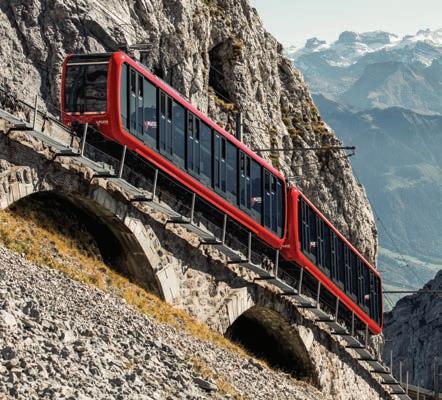
2 minute read
A DIFFICULT CLIMB
Swiss railway employs secure, high redundancy wireless network technology to revamp world’s steepest cogwheel railway.
The Pilatus-Bahnen railway was built over 130 years ago but is still the world’s steepest cogwheel railway. The train climbs the path from the Swiss village of Alpnachstad to the summit of Mount Pilatus at an elevation of 2,073m (6,801 ft). During the trip, with its average gradient of 35%, passengers are able to view flowering alpine meadows, striking rock formations and snowfields.
The railway has become one of Switzerland’s most successful tourist attractions. Because of its popularity and large number of passengers, the railway needed larger and faster rail vehicles equipped with modern technology.
The control system used in the original trains was based on mechanical and electromechanical control elements. For the new larger and faster trains, Swiss process automation and railway safety firm, Actemium LeitTec, installed an electronic train control system to connect the route’s trackside control units with its moving trains, using wireless data communication.
For this, the company developed a PbS (position-based signalling) wireless network to provide high levels of data availability and satisfy the railway’s exceptionally high reliability demands. Due to its experience in rail communications and its data communication products, Pilatus and Actemium turned to Westermo to meet the railway’s reliability and availability requirements.
“A project like this one has never been built before and is essentially a prototype,” said Patrick Blaser, operations manager and member of the executive board at Pilatus. “To be able to accomplish this project, we needed partners like Westermo who actively contribute their know-how and support us with planning.”
In collaboration with Actemium, Westermo engineers designed and installed the data network directly on the mountain. Based on a redundant
Ethernet ring architecture, the network consists of wireless and wired devices designed for maximum reliability.
To that end, the system employs FRNT (fast recovery network topology), Westermo’s ring protocol for high-availability Ethernet networks. The ring architecture ensures data transfer via other paths in the event of a device or network link failure.
Furthermore, to ensure that the network can be operated securely and is protected from the outside, a number of security functions, such as data encryption, port security, active firewalls and other mechanisms for a secure data network, were already taken into account in the concept and later implemented.
Westermo Ibex-RT-370 infrastructure access points were installed trackside to provide WLAN connection to the vehicles, along with redundant routing switches with firewall functionality in the stations. The network onboard the trains is based on Westermo Viper-212A managed routing switches and Ibex-RT-320 wireless clients that communicate over Wi-Fi with the trackside access points. This train-to-ground communication network setup ensures reliable communication between the trains and the control system.
In addition, a collision warning system between the trains was implemented using Westermo wireless technology. A WLAN connection is automatically established between two vehicles when they approach each other. This connection allows the steering systems to exchange data, enabling them to travel virtually in tandem and avoid collisions.
There is often over 10 meters of snow on the Pilatus summit in winter. To protect the infrastructure from these masses of snow and water, it is partially dismantled in autumn and reassembled in spring. To simplify and streamline this process, a trackside radio equipment (TRE) box was developed, containing WLAN access points, antennas and power splitters.
Thanks to a sophisticated assembly and disassembly system, the boxes can be easily dismantled in the autumn and reassembled in the spring. This also ensures that the antennas mounted on the TRE box are correctly aligned again after reassembly.
Mount Pilatus is an extremely unique place, with its highest point over 2000 meters above sea level and exposed to extreme geological weather conditions. To ensure the installation was successful, all companies involved had to work closely together. Occasionally, work could not be carried out as planned due to geological or weather conditions, requiring a high degree of collaboration and flexibility.
“Throughout the project process, we were able to rely on Westermo and benefit from their expertise in secure, industrial networks and WLAN systems,” said Actemium Project Manager, Peter Tschan. “Together, we developed network concepts with integrated cyber-security. Additionally, Westermo was on-site during commissioning to support us. This saved us a lot of time and money.” |DE www.westermo.com







